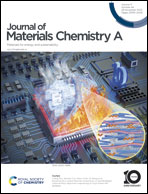Constructing carbon nanotube-optimized hollow Ti3C2 MXene hierarchical conductive networks for robust lithium–sulfur batteries†
Abstract
Constructing a hierarchical 3D conductive network structure as the sulfur host is an effective attempt to mitigate the polysulfide (LiPS) shuttle and expedite the reaction kinetics in lithium–sulfur batteries (LSBs). In this research, 3D hollow Ti3C2 MXene spheres have been synthesized by the template method, with 1D carbon nanotubes (CNTs) grown in situ on their surface (Ti3C2@N-CNTs). The hollow Ti3C2 spheres avoid self-stacking thus exposing more active sites, while the 1D CNTs form an interconnected conductive network. The synergistic effect enhances the adsorption and catalytic conversion of LiPSs and simultaneously facilitates rapid ion diffusion and electron transfer. With these advantages, the LSBs constructed from Ti3C2@N-CNTs exhibit a satisfactory initial discharge capacity of 1214 mA h g−1 at 0.2C, as well as the average capacity decay rate per cycle is only 0.015% after 1000 cycles at 1C. Furthermore, an areal capacity of 4.3 mA h cm−2 can be achieved at a higher sulfur loading of 4.8 mg cm−2.



 Please wait while we load your content...
Please wait while we load your content...